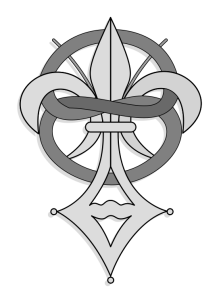
Back دير صهيون Arabic Sion Prioratı Azerbaijani Орден на Сион Bulgarian প্রায়োরি অফ সায়োন Bengali/Bangla Priorat de Sió Catalan Převorství sionské Czech Sions Priorat Danish Prieuré de Sion German Κοινό της Σιών Greek Priorato de Sion Spanish
This article has an unclear citation style. (October 2020) |

The Prieuré de Sion (French pronunciation: [pʁijœʁe də sjɔ̃]), translated as Priory of Sion, was a fraternal organisation founded and dissolved in France in 1956 by Pierre Plantard in his failed attempt to create a prestigious neo-chivalric order.[2] In the 1960s, Plantard began claiming that his self-styled order was the latest front for a secret society founded by crusading knight Godfrey of Bouillon, on Mount Zion in the Kingdom of Jerusalem in 1099, under the guise of the historical monastic order of the Abbey of Our Lady of Mount Zion. As a framework for his grandiose assertion of being both the Great Monarch prophesied by Nostradamus and a Merovingian pretender, Plantard further claimed the Priory of Sion was engaged in a centuries-long benevolent conspiracy to install a secret bloodline of the Merovingian dynasty on the thrones of France and the rest of Europe.[2][3] To Plantard's surprise, all of his claims were fused with the notion of a Jesus bloodline and popularised by the authors of the 1982 speculative nonfiction book The Holy Blood and the Holy Grail,[1] whose conclusions would later be borrowed by Dan Brown for his 2003 mystery thriller novel The Da Vinci Code.[4][5]
After attracting varying degrees of public attention from the late 1960s to the 1980s, the mythical history of the Priory of Sion was exposed as a ludibrium — an elaborate hoax in the form of an esoteric puzzle — created by Plantard as part of his unsuccessful stratagem to become a respected, influential and wealthy player in French esotericist and monarchist circles. Pieces of evidence presented in support of the historical existence and activities of the Priory of Sion before 1956, such as the so-called Dossiers Secrets d'Henri Lobineau, were discovered to have been forged and then planted in various locations around France by Plantard and his accomplices.[6]
Despite the "Priory of Sion mysteries" having been exhaustively debunked by journalists and scholars as France's greatest 20th-century literary hoax,[6][7][8] many conspiracy theorists still persist in believing that the Priory of Sion was a millennium-old cabal concealing a religiously subversive secret. A few independent researchers outside of academia claim, based on alleged insider information, that the Priory of Sion continues to operate as a conspiratorial secret society to this day.[9][10][11][12][13] Some skeptics express concern that the proliferation and popularity of pseudohistorical books, websites and films inspired by the Priory of Sion hoax contribute to the problem of unfounded conspiracy theories becoming mainstream;[14] while others are troubled by how these works romanticize the reactionary ideologies of the far right.[15]
- ^ a b Baigent, Michael; Leigh, Richard; Lincoln, Henry (1982). The Holy Blood and the Holy Grail. Jonathan Cape. ISBN 978-0-224-01735-0.
- ^ a b Massimo Introvigne (2–5 June 2005). "Beyond The Da Vinci Code: History and Myth of the Priory of Sion". CESNUR. Retrieved 20 November 2012.
{{cite journal}}: Cite journal requires|journal=(help) - ^ Pierre Plantard, Gisors et son secret..., ORBIS, 1961, abridged version contained in Gérard de Sède, Les Templiers sont parmi nous. 1962.
- ^ Dan Brown (2003). The Da Vinci Code. Doubleday. ISBN 0-385-50420-9.
- ^ Chapter 21 by Cory James Rushton, "Twenty-First-Century Templar", p. 236, in Gail Ashton (editor), Medieval Afterlives in Contemporary Culture (Bloomsbury Academic, 2015. ISBN 978-1-4411-2960-4).
- ^ a b Bill Putnam, John Edwin Wood (2003). The Treasure of Rennes-le-Château. A Mystery Solved. Sutton Publishing. ISBN 0750930810.
- ^ Bradley, Ed (2006). "The Priory Of Sion: Is The "Secret Organization" Fact Or Fiction?". Retrieved 16 July 2008.
{{cite journal}}: Cite journal requires|journal=(help) - ^ Melissa Kasoutlis (2009). Literary Hoaxes: An Eye-Opening History of Famous Frauds. Skyhorse. ISBN 978-1602397941.
- ^ Michael Baigent, Richard Leigh, Henry Lincoln (1987). The Messianic Legacy. Henry Holt & Co. ISBN 9780805005684.
{{cite book}}: CS1 maint: multiple names: authors list (link) - ^ Lynn Picknett, Clive Prince (1997). The Templar Revelation: Secret Guardians of the True Identity of Christ. Bantam Press. ISBN 0593038703.
- ^ Laurence Gardner (2005). The Magdalene Legacy: The Jesus and Mary Bloodline Conspiracy. Harpercollins Pub Ltd. ISBN 0007200846.
- ^ Lynn Picknett, Clive Prince (2006). The Sion Revelation. The Truth About the Guardians of Christ's Sacred Bloodline. Touchstone. ISBN 0-7432-6303-0.
- ^ Robert Howells (2011). Inside the Priory of Sion: Revelations from the World's Most Secret Society. Watkins Publishing. ISBN 978-1-78028-136-0.
- ^ Mondschein, Ken (11 November 2014). "Holy Blood, Holy Grail". Straus Media. Straus News. Retrieved 7 October 2020.
Likewise, there's an entire cottage industry devoted to disseminating crazy conspiracy theories about the Knights Templar, from Richard Metzger's Disinfo.com (which seems to be more interested in the believers than the belief) to Dagobert's Revenge, the New Jersey-based conspiracy zine to which industrial musician Boyd Rice is a prominent contributor (it's named for a murdered Merovingian king). I've heard everything from the Templars having hidden the Ark of the Covenant in Ethiopia to their having built a supposed medieval tower in Connecticut a hundred years before Columbus sailed the ocean blue. The sad truth is that, while remnants survived in such groups as the Knights of Christ in Portugal, the Templars have about as much effect on the modern world as does the Empire of Trebezonia.
- ^ David Klinghoffer, "The Da Vinci Protocols: Jews should worry about Dan Brown’s success" Archived 7 September 2009 at the Wayback Machine, National Review Online, 2006. Retrieved on 28 March 2008.